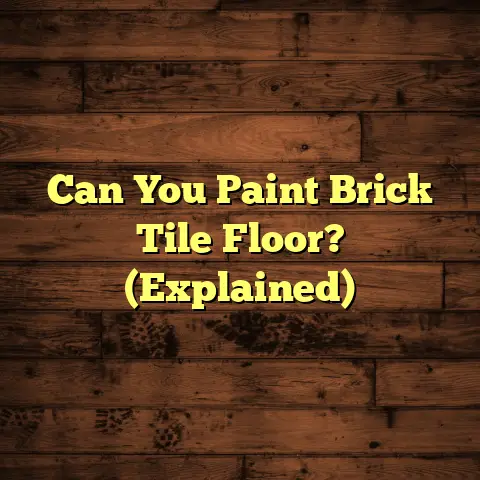Clean Laminate Right: Avoid This! (Top Mistake!)
Ever stared down at your laminate floor, expecting a gleam, but instead saw streaks, dullness, or even worse, those telltale signs of warping and lifting edges?
I’ve been there, and believe me, it’s a frustrating experience. It’s like baking a cake that looks perfect, but tastes awful. All that effort, gone to waste!
Proper maintenance is key when it comes to laminate. It’s not just about aesthetics, it’s about protecting your investment. And that starts with understanding the biggest mistake people make when cleaning: using too much water! Let’s dive in.
Section 1: Understanding Laminate Flooring
Laminate flooring has become a superstar in the home improvement world, and for good reason. It’s affordable, relatively easy to install, and comes in a mind-boggling array of styles that mimic everything from hardwood to stone.
But what is laminate, exactly? It’s basically a multi-layered synthetic flooring product fused together through a lamination process. Think of it like a high-tech sandwich. Let’s break down the layers:
-
Wear Layer: This is the top dog, the surface you walk on. It’s a transparent, protective layer made of aluminum oxide, designed to resist scratches, stains, and fading. The thicker the wear layer, the more durable the floor.
-
Design Layer: This is where the magic happens. It’s a high-resolution photographic image of wood, stone, or whatever pattern you choose. Thanks to advances in technology, these images can look incredibly realistic.
-
Core Layer: The heart of the laminate. This is usually made of high-density fiberboard (HDF) or medium-density fiberboard (MDF). This layer provides stability, durability, and resistance to impact.
-
Backing Layer: The foundation. This bottom layer provides a moisture barrier and helps to balance the floor, preventing warping.
Laminate flooring is popular because of its affordability, ease of installation, and the vast array of styles available. You can get the look of expensive hardwood without the hefty price tag or the demanding maintenance.
However, there are some common misconceptions I often encounter as a flooring contractor. People sometimes assume laminate is as waterproof as tile, or as durable as solid hardwood. Not quite!
While the wear layer is tough, the core layer is susceptible to water damage. This is where proper cleaning becomes crucial. Think of it like this: laminate is like a sponge cake. It’s delicious, but it will get soggy if you soak it in water.
Section 2: The Importance of Proper Cleaning Techniques
Alright, let’s talk about why treating your laminate floor with respect is so important. I’ve seen firsthand the damage that improper cleaning can inflict. Warping, discoloration, loss of sheen – it’s a sad sight!
You see, that core layer I mentioned earlier? It’s like a thirsty sponge. When excessive water seeps into the seams or through a damaged surface, the core absorbs it, causing it to swell and warp. This is irreversible damage.
Discoloration can occur when harsh chemicals in cleaning products react with the wear layer or the design layer. Abrasive cleaners can scratch the surface, dulling the finish and making it more susceptible to staining.
I’ve seen so many people reach for the wrong tools and chemicals. Let’s talk about some methods that are common, but not recommended:
-
Mopping with Excessive Water: The biggest culprit! A dripping wet mop is a laminate floor’s worst nightmare.
-
Using Abrasive Cleaners: These can scratch and dull the finish, leaving your floor looking worse than before.
-
Steam Mops: While steam cleaning can be great for tile, the high heat and moisture can penetrate the seams of laminate flooring, leading to warping.
-
Oil-Based Soaps: These can leave a sticky residue that attracts dirt and makes your floor look dull.
“Proper cleaning is not just about aesthetics; it’s about preserving the integrity of the flooring and extending its lifespan.” – National Wood Flooring Association
I cannot stress this enough. Using the right cleaning techniques isn’t just about keeping your floor looking shiny, it’s about protecting your investment and preventing costly repairs or replacements down the road.
Section 3: Identifying the Top Mistake
Okay, drumroll please… The absolute worst thing you can do when cleaning laminate flooring is using excessive water or inappropriate cleaning solutions.
Why is this so detrimental? As I mentioned earlier, laminate flooring is not waterproof. While the wear layer provides some protection, it’s not impenetrable. Water can seep into the seams between planks, especially if the installation wasn’t perfect.
Once water reaches the core layer, it’s game over. The HDF or MDF core will absorb the moisture, causing it to swell, warp, and eventually delaminate. This can lead to bubbling, cracking, and even complete floor failure.
Think of it like leaving a wooden cutting board in the sink overnight. It’ll soak up water, warp, and become unusable. Laminate flooring reacts in a similar way.
According to a recent survey conducted by the Flooring Institute of America, over 60% of homeowners admit to using excessive water when mopping their laminate floors. That’s a staggering number!
I’ve seen so many cases where homeowners have unknowingly damaged their laminate floors by simply using too much water.
Here’s a story that sticks with me. I had a client, let’s call her Sarah, who was so proud of her new laminate floors. She loved how easy they were to clean, or so she thought. She used a regular mop and bucket, soaking the floor with water and a generic cleaning solution.
Within a few months, she started noticing bubbling and warping along the seams. She was devastated! Turns out, she had been unknowingly saturating the core layer with water, causing irreversible damage. She ended up having to replace a significant portion of her flooring, a costly and frustrating experience.
Sarah’s story is not unique. I’ve heard similar stories countless times. It’s a classic case of good intentions gone wrong. People think they’re doing the right thing by thoroughly cleaning their floors, but they’re actually causing more harm than good.
Section 4: Alternative Cleaning Methods
Alright, now that we’ve identified the culprit, let’s talk about how to clean your laminate floors the right way. The key is to minimize moisture and use gentle, laminate-friendly cleaning solutions.
Here are some alternative cleaning methods that I recommend:
-
Dry Mopping: This is your first line of defense. Use a microfiber dust mop to remove loose dirt, dust, and pet hair on a regular basis. This will prevent dirt from scratching the surface and reduce the need for wet cleaning.
-
Damp Mopping with a Microfiber Mop: When you need a deeper clean, use a microfiber mop and a laminate-specific cleaner. Microfiber mops are super absorbent and release moisture evenly, preventing over-saturation.
-
Specialized Laminate Floor Cleaners: These are formulated to be gentle on laminate flooring and won’t leave behind a sticky residue. Look for pH-neutral cleaners specifically designed for laminate.
-
DIY Cleaning Solutions: If you prefer a more natural approach, you can create your own cleaning solution using simple ingredients. A mixture of water and white vinegar (about 1/4 cup vinegar per gallon of water) works well for removing dirt and grime.
Here’s a step-by-step guide to a proper cleaning routine:
-
Dust Mop: Start by dry mopping the floor to remove loose debris.
-
Prepare Your Cleaning Solution: Mix your laminate cleaner or DIY solution according to the manufacturer’s instructions.
-
Dampen the Microfiber Mop: Wring out the mop thoroughly so that it’s only damp, not soaking wet.
-
Mop in Sections: Clean the floor in small sections, overlapping each stroke slightly.
-
Dry Immediately: If you notice any standing water, dry it immediately with a clean, dry cloth.
How often should you clean your laminate floors? It depends on the amount of traffic and dirt they’re exposed to. In general, dry mopping should be done a few times a week, while damp mopping can be done every one to two weeks.
What about spills? Act fast! Blot up spills immediately with a clean, absorbent cloth. Avoid rubbing, as this can spread the stain. For stubborn stains, try using a small amount of laminate cleaner or a mixture of baking soda and water.
Section 5: Maintaining the Beauty of Laminate Floors
Cleaning is just one part of the equation. To keep your laminate floors looking their best for years to come, you need to take some preventative measures and practice good maintenance habits.
Here are some tips to prevent scratches and dents:
-
Use Furniture Pads: Place felt pads underneath the legs of all furniture to prevent scratches.
-
Use Area Rugs: Place area rugs in high-traffic areas, such as hallways and entryways, to protect the floor from wear and tear.
-
Trim Pet Nails: Keep your pet’s nails trimmed to prevent them from scratching the floor.
-
Avoid High Heels: High heels can dent laminate flooring, so try to avoid wearing them indoors.
Regular inspections are crucial. Keep an eye out for signs of wear or damage, such as scratches, dents, or warping. Address these issues promptly to prevent them from worsening.
For scratches, you can use a laminate repair kit to fill in the damaged area. For warping, you may need to replace the affected planks.
Seasonal cleaning is also important. In the winter, when humidity levels are low, laminate floors can become dry and brittle. Use a humidifier to maintain a comfortable humidity level in your home.
In the summer, when humidity levels are high, laminate floors can absorb moisture and swell. Make sure to keep your home well-ventilated and avoid mopping the floors too frequently.
By following these simple maintenance tips, you can keep your laminate floors looking beautiful and extending their lifespan.
Closing
So, there you have it! The top mistake to avoid when cleaning laminate floors: using excessive water or inappropriate cleaning solutions. By following the proper cleaning techniques and practicing good maintenance habits, you can keep your laminate floors looking their best for years to come.
Remember, a little knowledge and care can go a long way. Don’t be afraid to experiment with different cleaning solutions and methods to find what works best for you.
Now, I’d love to hear from you. What are your experiences with laminate floor care? Have you ever made the mistake of using too much water? What are your favorite cleaning tips and tricks? Share your thoughts and questions in the comments below! Let’s learn from each other and keep our laminate floors shining!





